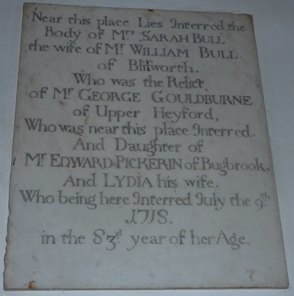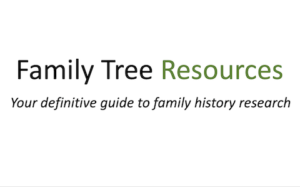Burial Records give details regarding the burial place and burial date of the deceased, but do not state the actual death date. This type of record is found in Parish Registers, some of these dating from 1538.
These records can be invaluable, especially if you are searching for someone who died prior to 1837, when civil registration began in England and Wales.
The main problem with searching for a person’s burial record is that you need to know where they were living and which church they attended. This can be much more difficult to determine if your ancestor lived in a town or city.
Burial Records Before 1813
Early entries in burial registers contained less information than those from later years. It was not uncommon for an entry in the register to simply state the person’s name, and contain no more details at all apart from the date of burial.
The lack of information makes it difficult to ascertain if you have found the correct entry, especially in a parish where a particular surname is common.
I Cannot Prove Person Buried Was My Relative – Should I Give Up?
NO!!! There are still many things you are able to try… Did they leave a will?? Wills can contain a wealth of information that may help you decide if this is the entry for your ancestor or not.
Another thing you could try is to see if there is a headstone for this person – this may help you conclude if you have found the correct entry.
A headstone or memorial plaque may contain much more information than that found in the burial register.

For example, this memorial plaque in St Peter and St Paul, Nether Heyford, Northamptonshire explains that Sarah Bull, wife of William Bull of Blisworth, Northamptonshire, was previously married to George Gouldburne of Upper Heyford, Northamptonshire.
It also explains that she was the daughter of Edward and Lydia Pickering of Bugbrooke, and had been interred on 9 July 1718 in the 83rd year of her age, allowing us to estimate that she was born in 1628.
Conducting further research, I was able to determine that she had been baptised on 27 September 1635 in Bugbrooke, Northamptonshire, showing how important it is to look a few years either side when searching for a baptism record.
Sarah’s burial entry in St Peter and St Paul, Nether Heyford simply states that she was the wife of Mr Bull of Blisworth, and gives no further information.
What Happened if a Child or a Wife/Widow Died?
In earlier burial records if a child was buried it sometimes stated the father’s name but the mother was not considered important enough to be mentioned.
In later registers, however, the mother’s name began to be mentioned.
If a wife died it sometimes stated the husband’s name, or if the husband was already deceased that she was a widow. This could be designated by the term ‘relict’. Knowing this information it may help you to determine when her husband had been buried.
Sometimes you may find more detail was added, such as their age or occupation. A lot depended on the clergyman and how much information he included in the entry.
Burial Records After 1813
After 1813 church burials were recorded in much more detail in a separate burial register. The deceased’s abode was now recorded along with the age at death.
In earlier registers, however, the age at death was sometimes recorded incorrectly so you should always search for a few years either side of this date in the baptism register.
The Columns in the Burial Register:
- Name of deceased
- Abode
- Burial Date
- Age at death
- By whom the ceremony was performed
If you find, when looking in a baptism register, two children share the same name, baptised around the same time, it is prudent to check if one of those children died in infancy. This could help you to ascertain which of the children is your ancestor. Sometimes, however, the parents’ names are not mentioned.
It is often useful to look through newspapers for any possible obituary as this could reveal family members previously unknown to you and it may lead to you discovering more information about the life of the deceased.
I Cannot Find My Ancestor’s Burial Record
By the late Victorian era, many churchyards were full, so having a church burial became less common. This did not just happen in the towns, it also happened in villages.
If your ancestor was nonconformist, they may have been buried in a cemetery rather than the chapel because some chapels did not have the space to allow for burials to take place.
It is also possible that a person was not buried where they had been living when they died. They may have decided to be buried somewhere they had lived previously, or with their spouse if married, or with their parents.
If your relative left a will, this may give some idea as to where they had been buried because they may have left instructions as to where they wished to be buried.
It may also be worth checking with some funeral directors because some keep archives and may have a record of where they transported the coffin.
Where to Find Burial Records
Burial records can usually be found in local county Record Offices. If you are looking for a burial that occurred more recently, however, it may be that the entry is in a register that is still being used by the church, especially if it is a smaller parish.
Some burial records have also been made available online at Dustydocs. This resource is incomplete as it is compiled by volunteers, but extra information is constantly being added.
Some burials have also been made available at FreeReg, which is an online database amassed by volunteers. This index is not yet complete.
You can peruse some baptism registers online at Ancestry and FindmyPast.
Ancestry
Ancestry is great for anyone who does not have the time to, or is unable to, visit Record Offices or Libraries.
It is especially good if you wish to access records from the comfort of your home.
Read my in-depth review to find out more about its features, advantages, and disadvantages.
FindmyPast
FindmyPast is good for anyone, whether they are just starting their family history journey, or have already conducted some research.
It is especially good for people who wish to read newspaper articles.
Read my in-depth review to find out more about its features, advantages and disadvantages.
